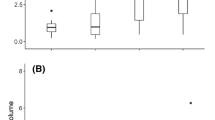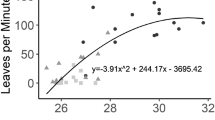Abstract
Small cursorial ectotherms risk overheating when foraging in the tropical forest canopy, where the surfaces of unshaded tree branches commonly exceed 50 °C. We quantified the heating and subsequent cooling rates of 11 common canopy ant species from Panama and tested the hypothesis that ant workers stop foraging at temperatures consistent with the prevention of overheating. We created hot experimental “sunflecks” on existing foraging trails of four ant species from different clades and spanning a broad range of body size, heating rate, and critical thermal maxima (CTmax). Different ant species exhibited very different heating rates in the lab, and these differences did not follow trends predicted by body size alone. Experiments with ant models showed that heating rates are strongly affected by color in addition to body size. Foraging workers of all species showed strong responses to heating and consistently abandoned focal sites between 36 and 44 °C. Atta colombica and Azteca trigona workers resumed foraging shortly after heat was removed, but Cephalotes atratus and Dolichoderus bispinosus workers continued to avoid the heated patch even after >5 min of cooling. Large foraging ants (C. atratus) responded slowly to developing thermal extremes, whereas small ants (A. trigona) evacuated sunflecks relatively quickly, and at lower estimated body temperatures than when revisiting previously heated patches. The results of this study provide the first field-based insight into how foraging ants respond behaviorally to the heterogeneous thermal landscape of the tropical forest canopy.







Similar content being viewed by others
References
Azócar DLM, Bonino MF, Perotti MG, Schulte JA, Abdala CS, Cruz FB (2016) Effect of body mass and melanism on heat balance in Liolaemus lizards of the goetschi clade. J Exper Biol 219:1162–1171. doi:10.1242/jeb.129007
Bestelmeyer BT, Wiens JA (2003) Scavenging ant foraging behavior and variation in the scale of nutrient redistribution among semi-arid grasslands. J Arid Environ 53:373–386. doi:10.1006/jare.2002.1044
Blomberg SP, Garland TJ, Ives AR (2003) Testing for phylogenetic signal in comparative data: behavioral traits are more labile. Evolution 57:717–745. doi:10.1111/j.0014-3820.2003.tb00285.x
Bujan J, Yanoviak SP, Kaspari ME (2016) Desiccation resistance in tropical insects: causes and mechanisms underlying variability in a Panama ant community. Ecol Evol 6:6282–6291. doi:10.1002/ece3.2355
Cerdá X, Retana J, Cros S (1998) Critical thermal limits in Mediterranean ant species: trade-off between mortality risk and foraging performance. Func Ecol 12:45–55. doi:10.1046/j.1365-2435.1998.00160.x
Clay NA, Bauer M, Solis M, Yanoviak SP (2010) Arboreal substrates influence foraging in tropical ants. Ecol Entomol 35:417–423. doi:10.1111/j.1365-2311.2010.01197.x
Clémencet J, Cournault L, Odent A, Doums C (2010) Worker thermal tolerance in the thermophilic ant Cataglyphis cursor (Hymenoptera, Formicidae). Insect Soc 57:11–15. doi:10.1007/s00040-009-0044-y
Crawshaw LI (1979) Responses to rapid temperature change in vertebrate ectotherms. Am Zool 19:225–237. doi:10.1093/icb/19.1.225
Denlinger DL, Yocum G (1998) Physiology of heat sensitivity. In: Hallman GJ, Denlinger DL (eds) Temperature sensitivity in insects and application in integrated pest management. Westview Press, Boulder, pp 7–54
Deutsch CA, Tewksbury JJ, Huey RB, Sheldon KS, Ghalambor CK, Haak DC, Martin PR (2008) Impacts of climate warming on terrestrial ectotherms across latitude. Proc Natl Acad Sci USA 105:6668–6672. doi:10.1073/pnas.0709472105
Diamond SE, Sorger DM, Hulcr J, Pelini SL, Toro ID, Hirsch C, Oberg E, Dunn RR (2012) Who likes it hot? A global analysis of the climatic, ecological, and evolutionary determinants of warming tolerance in ants. Glob. Change Biol 18:448–456. doi:10.1111/j.1365-2486.2011.02542.x
Endler JA (1993) The color of light in forests and its implications. Ecol Monogr 63:1–27. doi:10.2307/2937121
Gehring WJ, Wehner R (1995) Heat shock protein synthesis and thermotolerance in Cataglyphis, an ant from the Sahara desert. Proc Natl Acad Sci USA 92:2994–2998. doi:10.1073/pnas.92.7.2994
Hemmings Z, Andrew NR (2016) Effects of microclimate and species identity on body temperature and thermal tolerance of ants (Hymenoptera: Formicidae). Austral Entomol.doi: 10.1111/aen.12215. (In press)
Hoffmann AA, Chown SL, Clusella-Trullas S, Fox C (2013) Upper thermal limits in terrestrial ectotherms: how constrained are they? Func Ecol 27:934–949. doi:10.1111/j.1365-2435.2012.02036.x
Hölldobler B, Wilson EO (1990) The ants. Harvard University Press, Cambridge
Hood WG, Tschinkel WR (1990) Desiccation resistance in arboreal and terrestrial ants. Physiol Entomol 15:23–35. doi:10.1111/j.1365-3032.1990.tb00489.x
Huey R, Crill W, Kingsolver JG, Weber K (1992) A method for rapid measurement of heat or cold resistance of small insects. Func Ecol 6:489–494. doi:10.2307/2389288
Hurlbert AH, Ballantyne F, Powell S (2008) Shaking a leg and hot to trot: the effects of body size and temperature on running speed in ants. Ecol Entomol 33:144–154. doi:10.1111/j.1365-2311.2007.00962.x
Janzen DH (1966) Coevolution of mutualism between ants and acacias in Central America. Evolution 20:249–275. doi:10.2307/2406628
Janzen DH (1967) Why mountain passes are higher in the tropics. Am Nat 101:233–249
Kaspari M, Weiser MD (1999) The size-grain hypothesis and interspecific scaling in ants. Func Ecol 13:530–538. doi:10.1046/j.1365-2435.1999.00343.x
Kaspari M, Clay NA, Lucas J, Yanoviak SP, Kay A (2015) Thermal adaptation generates a diversity of thermal limits in a rainforest ant community. Global Change Biol 21:1092–1102. doi:10.1111/gcb.12750
Kaspari M, Clay NA, Lucas JM, Kay A, Yanoviak SP (2016) Thermal adaptation and phosphorus shape thermal performance in an assemblage of rainforest ants. Ecology 97:1038–1047. doi:10.1890/15-1225.1
Leigh EG Jr, Rand AS, Windsor DM (eds) (1996) The ecology of a tropical forest, 2nd edn. Smithsonian Institution, Washington
Lowe CH, Heath WG (1969) Behavioral and physiological responses to temperature in the desert pupfish Cyprinodon macularius. Physiol Zool 42:53–59
Madigosky SR (2004) Tropical microclimatic considerations. In: Lowman MD, Rinker HB (eds) Forest canopies, 2nd edn. Elsevier, Burlington, pp 24–48
Majerus ME, Majerus M (1998) Melanism: evolution in action. Oxford University Press, Oxford
Marsh AC (1985) Thermal responses and temperature tolerance in a diurnal desert ant, Ocymyrmex barbiger. Physiol Zool 58:629–636
Meisel JE (2006) Thermal ecology of the Neotropical army ant Eciton burchellii. Ecol Appl 16:913–922. doi:10.1890/1051-0761(2006)016[0913:TEOTNA]2.0.CO;2
Melville J, Schulte I, James A (2001) Correlates of active body temperatures and microhabitat occupation in nine species of central Australian agamid lizards. Austral Ecol 26:660–669. doi:10.1046/j.1442-9993.2001.01152.x
Moreau CS, Bell CD (2013) Testing the museum versus cradle tropical biological diversity hypothesis: phylogeny, diversification, and ancestral biogeographic range evolution of the ants. Evolution 67:2240–2257. doi:10.1111/evo.12105
Parker GG (1995) Structure and microclimate of forest canopies. In: Lowman MD, Nadkarni NM (eds) Forest canopies. Academic Press, San Diego, CA, pp 73–106
Penick CA, Tschinkel W (2008) Thermoregulatory brood transport in the fire ant, Solenopsis invicta. Insect Soc 55:176–182. doi:10.1007/s00040-008-0987-4
Pereboom JJM, Biesmeijer JC (2003) Thermal constraints for stingless bee foragers: the importance of body size and coloration. Oecologia 137:42–590. doi:10.1007/s00442-003-1324-2
Porter SD, Tschinkel WR (1993) Fire ant thermal preferences: behavioral control of growth and metabolism. Behav Ecol Sociobiol 32:321–329. doi:10.1007/BF00183787
Potter KA, Woods HA, Pincebourde S (2013) Microclimatic challenges in global change biology. Global Change Biol 19:2932–2939. doi:10.1111/gcb.12257
Ruano F, Tinuat A, Soler JJ (1999) High surface temperatures select for individual foraging in ants. Behav Ecol 11:396–404. doi:10.1093/beheco/11.4.396
Ruibal R (1961) Thermal relations of five species of tropical lizards. Evolution 15:98–111. doi:10.2307/2405846
SAS Institute Inc (2009) JMP statistical software version 11. SAS Institute, Cary
Scheffers BR, Phillips BL, Laurance WF, Sodhi NS, Diesmos A, Williams SE (2013) Increasing arboreality with altitude: a novel biogeographic dimension. Proc R Soc Lond B 280:20131581. doi:10.1098/rspb.2013.1581
Shi NN, Tsai C-C, Camino F, Bernard GD, Yu N, Wehner R (2015) Keeping cool: enhanced optical reflection and radiative heat dissipation in Saharan silver ants. Science 349:298–301. doi:10.1126/science.aab3564
Sinervo B, Mendez de la Cruz F, Miles DB, Heulin B, Bastiaans E, Villagrán-Santa Cruz M, Lara-Resendiz R, Martínez-Méndez N, Calderón-Espinosa ML, Meza-Lázaro RN (2010) Erosion of lizard diversity by climate change and altered thermal niches. Science 328:894–899. doi:10.1126/science.1184695
Sommer S, Wehner R (2012) Leg allometry in ants: extreme long-leggedness in thermophilic species. Arthropod Struct Dev 41:71–77. doi:10.1016/j.asd.2011.08.002
Stevenson RD (1985) Body size and limits to the daily range of body temperature in terrestrial ectotherms. Am Nat 125:102–117
Stuble KL, Pelini SL, Diamond SE, Fowler DA, Dunn RR, Sanders NJ (2013) Foraging by forest ants under experimental climatic warming: a test at two sites. Ecol Evol 3:482–491. doi:10.1002/ece3.473
Talbot M (1943) Response of the ant Prenolepis imparis Say to temperature and humidity changes. Ecology 24:345–352. doi:10.2307/1930536
van Oudenhove L, Boulay R, Lenoir A, Bernstein C, Cerda X (2012) Substrate temperature constrains recruitment and trail following behavior in ants. J Chem Ecol 38:802–809. doi:10.1007/s10886-012-0130-x
Vogel S (2013) Comparative biomechanics: life’s physical world. Princeton University Press, Princeton
Willmer PG, Unwin DM (1981) Field analyses of insect heat budgets: reflectance, size and heating rates. Oecologia 50:250–255. doi:10.1007/BF00348047
Yanoviak SP (2015) Effects of lianas on canopy arthropod community structure. In: Schnitzer SA, Bongers F, Burnham R, Putz FE (eds) The ecology of lianas. Wiley, Chichester, pp 345–361. doi:10.1002/9781118392409.ch24
Yanoviak SP, Kaspari M (2000) Community structure and the habitat templet: ants in the tropical forest canopy and litter. Oikos 89:259–266. doi:10.1034/j.1600-0706.2000.890206.x
Yanoviak SP, Schnitzer SA (2013) Functional roles of lianas for forest canopy animals. In: Lowman M, Devy S, Ganesh T (eds) Treetops at risk: challenges of global forest canopies. Springer, New York, pp 209–214. doi:10.1007/978-1-4614-7161-5_21
Yanoviak SP, Dudley R, Kaspari M (2005) Directed aerial descent in canopy ants. Nature 433:624–626. doi:10.1038/nature03254
Yanoviak SP, Silveri C, Hamm CA, Solis M (2012) Stem characteristics and ant body size in a Costa Rican rain forest. J Trop Ecol 28:199–204. doi:10.1017/S026646741100071X
Yanoviak SP, Silveri C, Stark AY, Van Stan JT, Levia DF (2016) Surface roughness affects the running speed of tropical canopy ants. Biotropica. doi: 10.1111/btp.12349. (In press)
Acknowledgements
We thank Oris Acevedo, Belkys Jimenez, and the staff of the Smithsonian Tropical Research Institute for logistical support in Panama. Amanda Winters assisted in the field. Comments from Jelena Bujan, Walter Carson, James Lichtenstein, and two anonymous reviewers improved the manuscript.
Author contribution statement
SPY, AYS, and BJA conceived and designed the experiments. MES, BJA, and AYS performed the experiments. SPY, MES, BJA, RK, and AYS analyzed the data. MK provided editorial advice, and all authors contributed to writing the manuscript.
Funding
This research was supported by National Science Foundation Grants DEB-1252614 to SPY, and DEB-0842038 and EF-1065844 to MK.
Author information
Authors and Affiliations
Corresponding author
Ethics declarations
Conflict of interest
The authors declare that they have no conflict of interest.
Human and animal rights
This article does not contain any studies with human participants or vertebrate animals performed by any of the authors.
Additional information
Communicated by Raphael Didham.
Electronic supplementary material
Below is the link to the electronic supplementary material.
Rights and permissions
About this article
Cite this article
Spicer, M.E., Stark, A.Y., Adams, B.J. et al. Thermal constraints on foraging of tropical canopy ants. Oecologia 183, 1007–1017 (2017). https://doi.org/10.1007/s00442-017-3825-4
Received:
Accepted:
Published:
Issue Date:
DOI: https://doi.org/10.1007/s00442-017-3825-4




